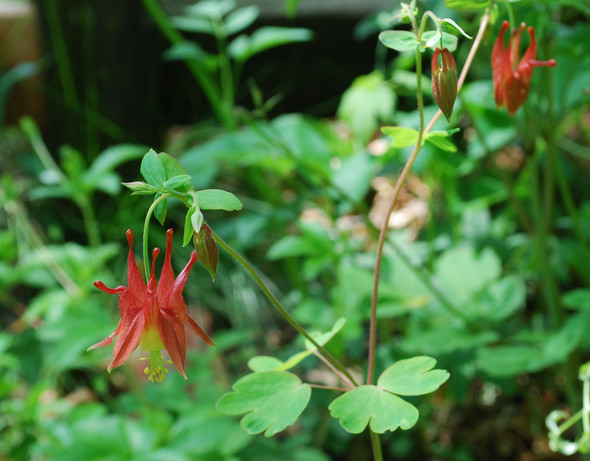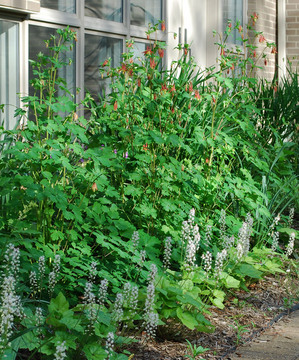Wild Columbine: A native plant stranger to our yard

Wild Columbine (Aquilegia canadensis) flowers make a nice snack for hummingbirds
Rick Meader | Contributor
In my little slice of the world there is a beautiful native flower that refuses to prosper. According to the books, it grows on rocky ledges, and it grows in rich soils, but it won’t grow in my somewhat fertile soil.
I have killed more than one in my continuing quest to establish a blooming colony to beautify my lawn and attract hummingbirds. Sometimes the planted plugs died of their own volition. Once, an accidental cutting (in the process of cutting adjacent weeds to make room for it to thrive), resulted in the lopping off of the lone flower I have managed to sprout in my yard. The plant disappeared soon after, probably a result of shame at having such a knuckleheaded farmer.
The plant is Wild Columbine (Aquilegia canadensis). It is my white whale.
First, a little information about this beautiful, interesting, obstinate flower. The plant grows to one to three feet high, in most cases, on a delicate plant that has compound leaves divided into three segments. It is a member of the Ranunculaceae (Buttercup) family, so it is cousins with buttercups, baneberries, anemones, black cohosh, rue anemone, marsh marigold, meadow rues, hepaticas and virgin’s bower, among many others.
Our columbine’s native territory is widely dispersed, from Texas up to Saskatchewan and east to Quebec and every state east of the Mississippi River. In Michigan, it is found in almost every county (seems to be easy to grow, doesn’t it?).
What makes the plant so spectacular are its oddly-shaped flowers. They are five-sectioned, yellow and red, horned flowers that hide nectar in its long projections inaccessible to all but the longest-tongued creatures (like hummingbirds). A mature plant may have many flowers blooming for a month, from spring into summer — a truly spectacular sight.
A quote from the Illinois Wildflowers website gives a clue to where it prefers to grow. “The preference is light shade to partial sun, moist to dry conditions, and soil that is loamy, rocky, or slightly sandy. Mature plants can also tolerate full sun, although young plants require some shade from neighboring vegetation. Once it becomes established, this plant is easy to maintain.”
They go on to list the very limited number of habitats in which it can be found: “Habitats include rocky open woodlands, wooded slopes, sandy savannas, thinly wooded bluffs, shaded areas of limestone cliffs, limestone glades, fens and bogs, openings in logged woodlands, and areas along railroad tracks (emphasis is mine)."

A very healthy, tall columbine (in someone else's yard) towers over foamflower (Tiarella cordifolia)
Rick Meader | Contributor
Now, for the real kickers. First, I have successfully grown Wild Columbine, for a client. In fact, the soil amendments I did worked so well that her plants are routinely four feet high, have oodles of flowers, and self-seed prolifically, to the point that the owner needs to remove the seedlings as weeds!
And, the piece de resistance (or however you spell it) to my shame is that, in fact, I can grow columbines in my yard on a regular basis. Some European columbines somehow made their way into our backyard garden and do quite well, even seeding themselves in my path. Oh, the cruel irony!
Well, the moral of the story is that this plant is one that you definitely want to add to your landscape, whether it is dominated by natives or aliens, and, based on its resilience in a lot of trying situations, you should be able to do so. Just don’t ask me how.
This week, blooming in our yard are lots of wild geranium, plus trillium, hairy sweet cicely, golden Alexander, False Solomon’s seal, Solomon’s Seal, Rosy sedge, Graceful sedge, woodland phlox, wild ginger, wild strawberry, common cinquefoil, fragrant sumac, yarrow, early meadow rue, Virginia waterleaf, foamflower and horse gentian. Get out and enjoy nature everyone!
Rick is a local landscape architect with a special interest in all things natural, including creating designs that include a lot of native plants (and the critters they support). You can contact him at yourland1824@gmail.com.


Comments
Rork Kuick
Tue, May 8, 2012 : 6:28 p.m.
I've got nothing. The locations that I find these in the wild don't fit a pattern I can see. Locally, wet and a bit acid seem popular, but in southern Ontario and northern Michigan, limestone areas seem to work fine.